| |
|
|
|
|
|
|
|
|
|
|
| |
| |
 |
|
| |
田润德 编译文/图 2020-08-22
19:36 |
|
| |
|
|
|
|
| |
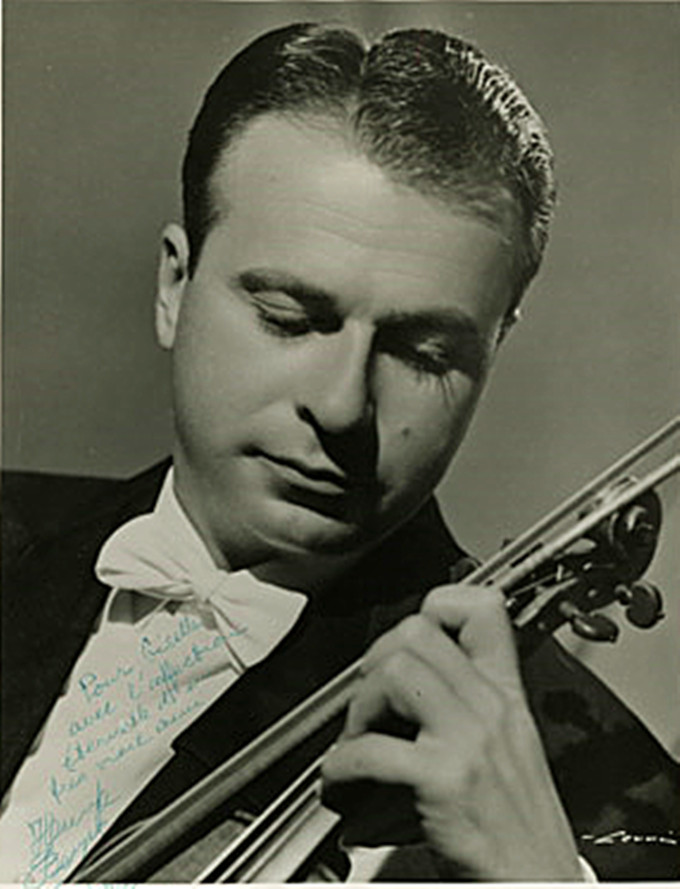 |
|
|
|
|
| |
亨利克·谢霖 (Henryk Szeryng
1918-1988) |
|
|
|
| |
|
|
| |
亨利克·谢林演奏贝多芬小提琴协奏曲。
|
|
|
|
| |
贝多芬小提琴协奏曲。 (亨利克·谢林)。
萨尔布吕肯广播交响乐团。 DyryzhørHansZehnder。
Beethoven Violin Concerto. Henryk Szeryng - violin
Rundfunk Sinfonieorchester Saarbrücken. Dyryzhёr Hans Zehnder. |
|
|
|
| |
|
|
|
|
| |
音乐历史上的今天
1918年9月22日,墨西哥籍波兰小提琴家谢霖出生于波兰华沙。
亨利克·谢霖(Henryk
Szeryng 1918-1988),墨西哥小提琴家,生于波兰华沙。7岁时其才华受到波兰小提琴大师胡贝尔曼的赏识,举荐他到柏林做了弗莱什的弟子,由此打下坚实的基础。1930年转至巴黎音乐院,师从法国大师蒂博、布兰杰,6年后毕业。
1944年谢霖受墨西哥音乐之父彭斯的感召而移居该国,两年后获得国籍,成为墨西哥公民。他被认为是巴赫作品最杰出的诠释者之一。第二次世界大战期间担任波兰流亡政府翻译撤到墨西哥,后来归
成为墨国公民,持外交护照担任文化大使。
1954年经好友鲁宾斯坦鼓励重返演艺舞台,逐渐被肯定为二十世纪最伟大的小提琴家之一。
谢霖先后从黑斯、弗莱什与蒂博学琴。1933年举行首次独奏音乐会。1946年移居墨西哥,在墨西哥大学音乐系任教。两年后获墨西哥国籍。
谢霖的演奏紧密而活跃,强调对作品的深度表达。他对巴洛克时期的音乐素有研究,演奏体现出纯正的巴洛克风格,优雅而严谨,被视为这方面的典范,同时也是巴赫作品最杰出的诠释者之一。
今日视频:1、亨利克·谢霖演奏贝多芬小提琴协奏曲;2、亨利克·谢霖演奏《帕格尼尼E大调第三小提琴协奏曲 》(世界首演)。 |
|
|
|
| |
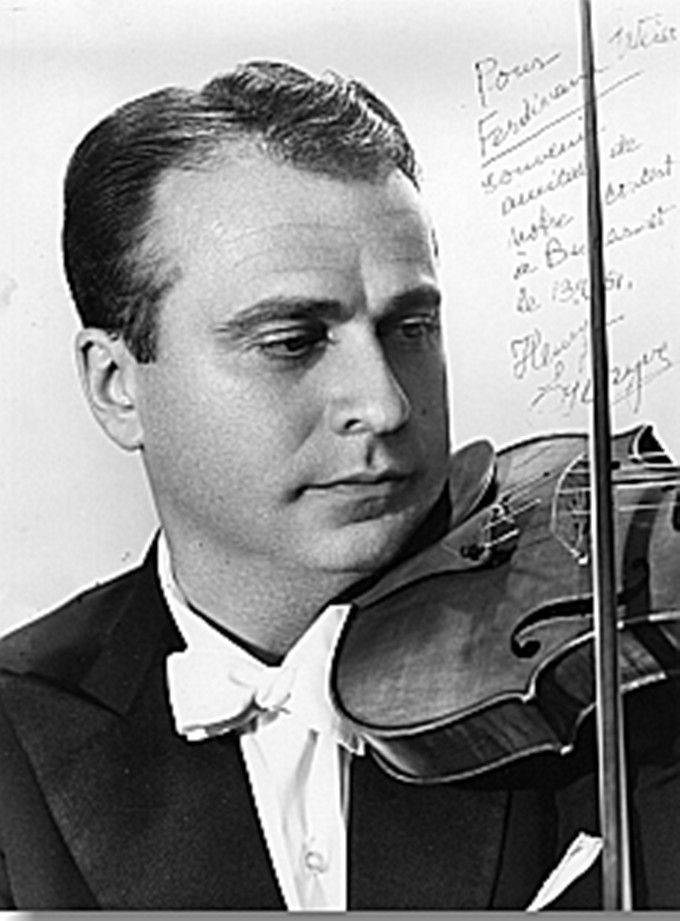 |
|
|
|
| |
亨利克·谢霖 (Henryk
Szeryng ) |
|
|
|
| |
不朽的小提琴家之一谢霖专页——[英]玛格丽特.坎贝尔著 |
|
|
|
| |
亨利克·谢霖的名字今天已经广为人知了,但是很少有人知道约瑟夫·哈西德。这两位艺术家都是诞生在波兰,彼此只相差五岁。
谢霖在六十一岁时,拿着外交护照在世界各地旅行;而哈西德却在二十七岁时,于精神病医院的一次失败的脑部手术后逝世。他是一位精神分裂症患者。
亨利克·谢霖于1918年诞生在华沙一个热爱音乐且富有的犹太工业家的家庭里。五岁时跟母亲学习钢琴,两年后跟哥哥学习小提琴。他的哥哥是位律师,也是一位优秀的业余小提琴爱好者。谢
霖之所以对小提琴感兴趣,是因为他觉得与钢琴相比,小提琴是这么小,而这么小的一件乐器在大演奏厅里竟能发出如此宏大的声音。他在小提琴学习上进步很快,不久后成为莫里斯·弗伦克尔的学生,弗伦克尔是奥尔在圣彼得堡的学生和助教。今天
谢霖很清楚地感到弗伦克尔给过他巨大的帮助,各个不同的小提琴演奏学派之间实际上是“非常紧密地互相联系在一起的”。 |
|
|
|
| |
One of
the immortal violinists, Schelling's page - [English] Margaret
Campbell Author |
|
|
|
| |
Henrik
Schelling's name is widely known today, but few people know
about Joseph Hasid. Both artists were born in Poland, only five
years apart from each other. Xie Lin traveled the world on a
diplomatic passport at the age of 61; Hasid died at the age of
27 after a failed brain surgery in a psychiatric hospital. He is
a schizophrenic.
Henrik Schelling was born in Warsaw in 1918 to a family of
wealthy Jewish industrialists who loved music. When he was five
years old, he studied piano with his mother, and two years
later, he studied violin with his brother. His older brother is
a lawyer and an excellent amateur violinist. Schellenge was
interested in the violin because he felt that the violin was so
small compared to the piano, and that such a small instrument
could produce such a grand sound in a large concert hall. He
progressed rapidly in his violin studies and soon became a
student of Maurice Frenkel, Orr's student and teaching assistant
in St. Petersburg. Today, Xie Lin clearly feels that Frenkel has
given him a great help, and the various schools of violin
playing are actually "very closely connected with each other". |
|
|
|
| |
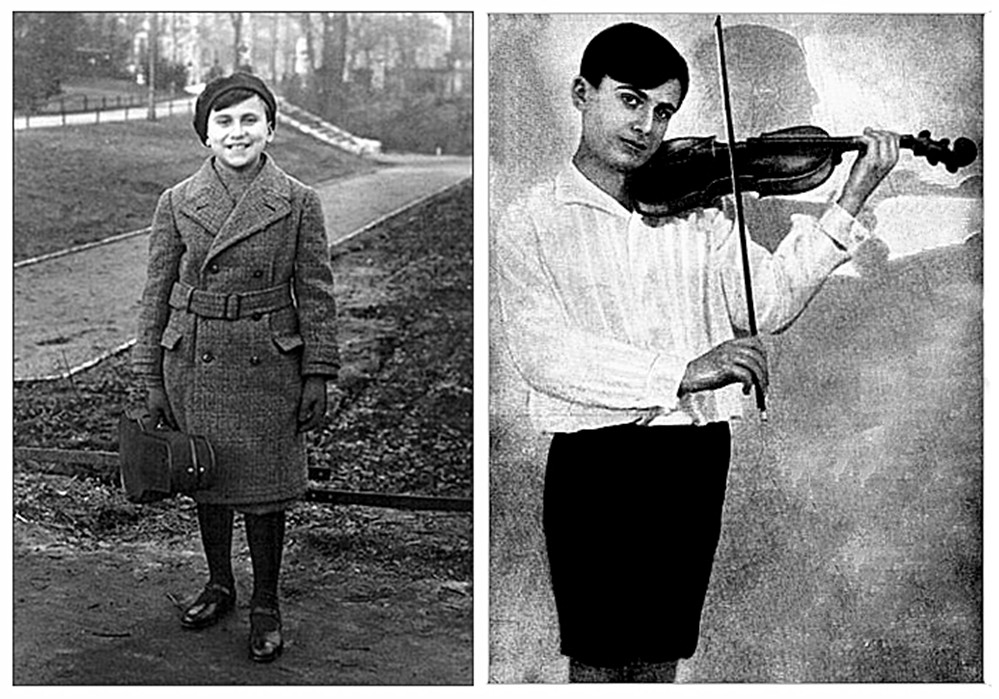 |
|
| |
少年时代的亨利克·谢霖 (Henryk
Szeryng ) |
|
|
|
| |
胡贝尔曼听了十岁的谢霖演奏门德尔松小提琴协奏曲后深受感动,便建议他到柏林去跟弗莱什学琴。谢伦格接受他的建议,到柏林去跟弗莱什学习了三年。1932年谢伦格一家移居巴黎,在那里认识了许多著名的诗人、画家和作曲家,并且跟纳迪亚·布朗热学习作曲。当他听了蒂博和克莱斯勒的演奏之后,深为法国小提琴学派的演奏风格所打动。克莱斯勒的优美典雅,以及对待小提琴演奏的态度,都是至今为止他在别的老师那里所没能学到的东西。关于蒂博,他说:“他没有海菲茨的技巧,也没有埃尔曼的力量,但是他的演奏,特别是在他情绪好的时候,却不比任何人差。”由于这两位演奏家的
影响,谢霖决定到巴黎音乐学院进行深造。1937年他以小提琴专业的第一名毕业于巴黎音乐学院,并从此开始了他的演奏生涯。
当希特勒入侵波兰时,谢霖只有二十一岁,于是他立即入伍波兰军队。由于当时他已经能流畅地讲六种语言,所以就被任命为西科尔斯基将军的联络员和翻译,而且被批准带着他的小提琴外出工作。他为伤者和他们的家属演出了大约三百场的音乐会,还在战俘营里演奏。谢
霖的达段经历使他更加确信音乐的动人力量——音乐把士兵和普通人民联系在一起,把澳洲与新西兰军团、捷克人、波兰人和墨西哥人联系在一起。
谢霖还对各种类型的音乐感兴趣,包括民间音乐、流行音乐、摇滚乐和爵士乐,并且认为这些音乐都是起源于古典音乐。谢伦格弹得一手好钢琴,休闲时还演奏爵士乐。 |
|
|
|
| |
Hubermann
was deeply moved by the ten-year-old Xie Lin playing the
Mendelssohn Violin Concerto, and suggested that he go to Berlin
to study with Fleish. Schellenge took his advice and went to
Berlin to study with Fleish for three years. In 1932, the
Schellenge family moved to Paris, where they met many famous
poets, painters and composers, and studied composition with
Nadia Boulanger. After listening to Thibaut and Chrysler's
performances, he was deeply moved by the playing style of the
French violin school. Chrysler's graceful elegance, as well as
his attitude towards violin playing, are things he has not been
able to learn from other teachers so far. Regarding Tebow, he
said: "He doesn't have the skills of Heifetz or the power of
Elman, but his playing, especially when he's in a good mood, is
no worse than anyone else." Due to the influence of the family,
Schellenge decided to study at the Paris Conservatoire. In 1937,
he graduated from the Paris Conservatory of Music with the first
place in the violin major and began his playing career.
When Hitler invaded Poland, Xie Lin was only twenty-one years
old, so he immediately enlisted in the Polish army. Since he was
fluent in six languages at the time, he was appointed General
Sikorsky's liaison and translator, and was authorized to take
his violin to work. He performed some 300 concerts for the
wounded and their families, as well as in prisoner-of-war camps.
Schellenger's long-term experience has made him more convinced
of the moving power of music - music that connects soldiers with
ordinary people, Australia with the New Zealand Army Corps,
Czechs, Poles and Mexicans. Xie Lin is also interested in
various types of music, including folk, pop, rock, and jazz, and
believes that these music originated from classical music.
Schellenge played the piano well and played jazz in his spare
time. |
|
|
|
| |
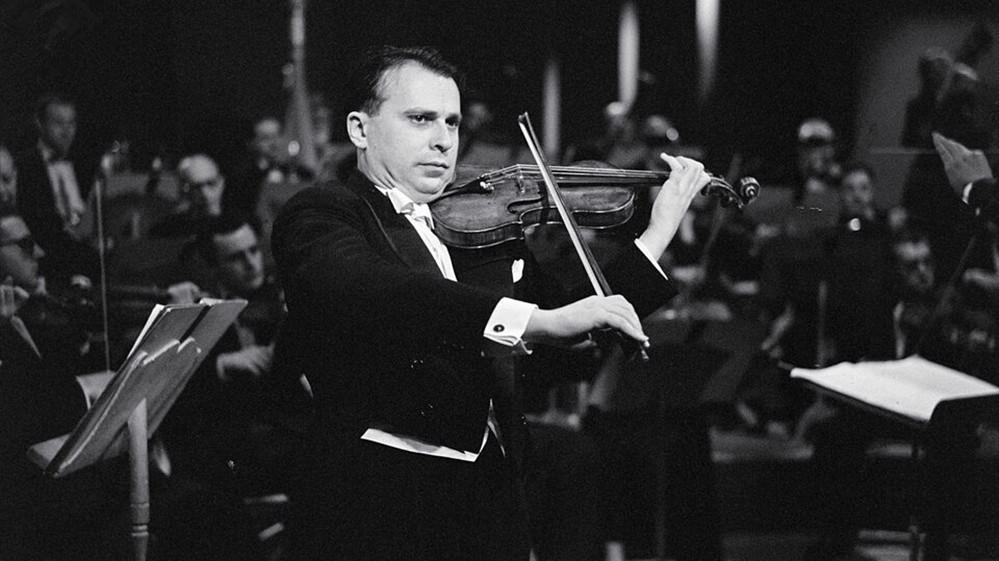 |
|
| |
亨利克·谢霖 (Henryk
Szeryng ) |
|
|
|
| |
1942年,谢霖陪同流亡于国外的波兰总理到拉丁美洲,为因战争而流离失所的四千名波兰难民寻求住所。墨西哥接受可这四千名波兰难民,
谢霖深受感动,于是战后来到墨西哥从事教学工作,并于1946年成为墨西哥公民。后来他成为墨西哥政府的文化外交官员,主要从事与没有外交关系的国家之间的文化交流活动,“因为我认为音乐应当绝对超脱政治”。
1954年秋,阿图尔·鲁宾斯坦来到墨西哥举行一系列的钢琴音乐会。谢伦格听了他的音乐会,并为他的演奏所打动,就到后台用波兰语向鲁宾斯坦祝贺。鲁宾斯坦对这位能讲波兰语的墨西哥人很感兴趣,就建议他们第二天再见一次面。
当谢伦格演奏给鲁宾斯坦听之后,这位大师反过来被谢霖的演奏所打动,就鼓励这位脱离音乐会舞台长达十二年之久的音乐家重新回到舞台上去。经鲁宾斯坦向音乐演出经理索尔·胡罗克介绍后,
谢霖立即就到美国进行巡回演出,并于1956年首次到欧洲进行演出。
谢霖重新回到舞台的日寸候已经三十六岁。三十多年之后的今天,他仍然在世界各地演出、录制唱片,并从事繁忙的教学工作(他在墨西哥大学音乐学院,担任由他于1
946年亲手建立起来的弦乐系的系主任)。谢霖的演奏曲目包括所有的古典协奏曲和许多现代的作品,其中也有墨西哥现代作曲家的作品0
1966年的爱丁堡音乐节,他首次在欧洲演奏了他的朋友卡洛斯·查维斯的协奏曲。他在一个月前已经举行了这首协奏曲的首演。
1971年10月10日,他在亚历山大·吉布森指挥伦敦交响乐团的协奏下,首次在皇家节日大厅演奏被人们认为“佚失”的帕格尼尼《第三小提琴协奏曲》,引起人们的兴奋。人们认为这首协奏曲的手稿毁于拿破仑的战争之中,后来经过
谢霖的挖掘工作才又被找了出来。多年来他一直在寻找这首协奏曲,后来他十分愉快地结识了帕格尼尼的两位已经八十多的曾孙女。这两位老妇人建议他应当多演奏一些帕格尼尼的作品,并给他看一堆已经放置了一百多年没有人动过的乐谱。
谢霖开始整理这些分散的乐谱。“我们花了五天的时间才把第一乐章拼起来!最后我们终于找到了整首协奏曲。”经过两位著名的意大利音乐学家的验证,这就是佚失的《第三协奏曲》。谢伦格录制了这首协奏曲,并且在伦敦首演之前便发行。斯坦利·萨迪在《泰晤士报》上这样写道:
这里有着极快的击跳弓,这些音符简直就像一串串的珍珠;有着棘手的八度、三度、六度和十度的双音,有时还插进一些颤音;有着很快的左手拨弦;有着用泛音演奏的很长的乐句,有时甚至是双泛音,我真怀疑谢伦格先生有多少手指?……这些泛音演奏得既甜蜜又纯净,运弓清晰而有节奏,发出的声音像白银一样闪闪发光……我希望句子能演奏得更热情一点,节奏能更自由一些,有着更多吉普赛风格。毕竟,帕格尼尼是被谣传曾经和魔鬼打过交道的人:谢伦格先生的演奏有着魔鬼般的辉煌,但是更多是天使般的纯净和真诚。 |
|
|
|
| |
In 1942,
Xie Lin accompanied the exiled Polish Prime Minister to Latin
America to seek shelter for 4,000 Polish refugees displaced by
the war. Xie Lin was deeply moved by Mexico's acceptance of
these 4,000 Polish refugees, so he went to Mexico to engage in
teaching after the war and became a Mexican citizen in 1946. He
later became a cultural diplomat for the Mexican government,
mainly engaged in cultural exchanges with countries without
diplomatic relations, "because I think music should be
absolutely detached from politics".
In the autumn of 1954, Arthur Rubinstein came to Mexico to give
a series of piano concerts. Schellenge listened to his concert
and was so moved by his performance that he went backstage to
congratulate Rubinstein in Polish. Rubinstein was so intrigued
by the Polish-speaking Mexican that he suggested they meet again
the next day.
When Schellenge played to Rubinstein, the master was moved by
Xie Lin's performance and encouraged the musician, who had been
away from the concert stage for 12 years, to return to the
stage. After being introduced by Rubinstein to music performance
manager Saul Hurock, Xie Lin immediately toured the United
States and made his first European tour in 1956.
Xie Lin was thirty-six years old when he returned to the stage.
More than three decades later, he is still performing,
recording, and teaching around the world (he is head of the
string department at the University of Mexico's Conservatory of
Music, which he founded in 1946). . Xie Lin's repertoire
includes all classical concertos and many modern works,
including works by modern Mexican composers. At the Edinburgh
Festival in 1966, he performed his friend Carlos Chavez's
concerto for the first time in Europe. He had already given the
concerto's premiere a month ago.
On October 10, 1971, he played Paganini's Violin Concerto No. 3,
thought to be "lost", for the first time at the Royal Festival
Hall under Alexander Gibson's concerto with the London Symphony
Orchestra. . It is believed that the manuscript of the concerto
was destroyed in Napoleon's wars, and was later recovered by Xie
Lin's excavations. He had been searching for this concerto for
many years, and then he had the pleasure of meeting two of
Paganini's great-granddaughters, who were in their eighties. The
two old women suggested that he should play more of Paganini,
and showed him a pile of scores that had been left untouched for
over a hundred years. Xie Lin began to organize these scattered
scores. "It took us five days to put together the first
movement! Finally we finally found the whole concerto." After
verification by two famous Italian musicologists, this is the
lost "Third Concerto". Schellenge recorded the concerto and
released it ahead of its London premiere. Stanley Sadie wrote in
The Times:
There are extremely fast strumming bows, and the notes are like
strings of pearls; there are tricky doubles of octaves, thirds, sixths,
and tenths, sometimes with some vibrato inserted; there is a fast left
hand plucked strings; with long phrases played in overtones, sometimes
double overtones, I really doubt how many fingers Mr. Schellenge has?
...the overtones are played sweet and pure, the bowing is clear and
rhythmic, and the sound is sparkling like silver...I wish the sentences
were played a little more passionately, the rhythm freer, more gypsy .
After all, Paganini is the man rumored to have dealt with the devil: Mr.
Schellenge's playing has a devilish splendor, but more of an angelic
purity and sincerity.
|
|
|
|
| |
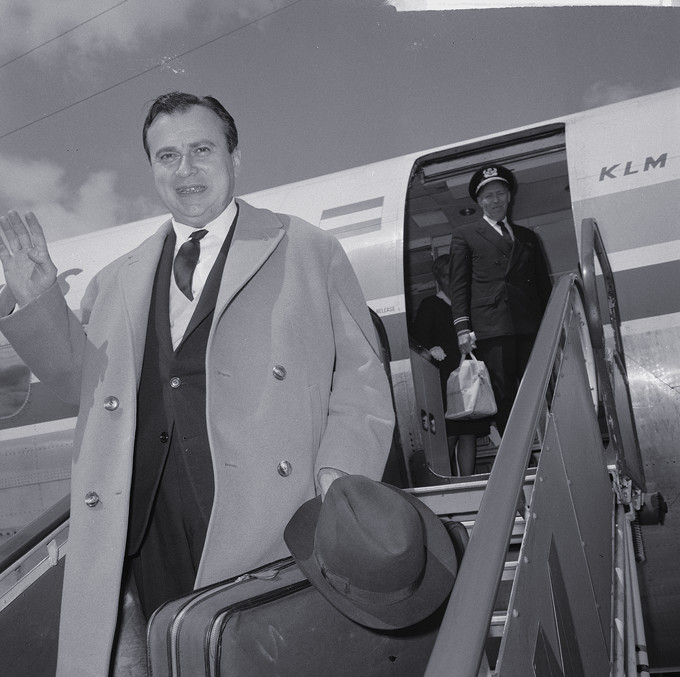 |
|
| |
亨利克·谢霖 (Henryk
Szeryng )演出途中 |
|
|
|
| |
这种看法也得到彼得·施塔德伦的证实,他在《每日电讯报》中写道:“谢霖先生以平静的幽默感演奏那些几乎是不能演奏的东西,而且取得了百分之九十九的成功,从而消除了人们认为帕格尼尼曾经和魔鬼打过交道的看法。”谢霖演奏风格的特点就是纯净,这种特点也可能不完全适合于帕袼尼尼的作品,但是在演奏巴赫时却是完全必要的。
谢霖录制的巴赫无伴奏奏鸣曲和古组曲被公认是最优秀的录音之一。关于1973年他在伊丽莎白女王大厅演奏的巴赫的笫三古组曲,《每日电讯报》的评论员说:“他演奏巴赫的‘前奏曲’绵延起伏,络绎不绝,把人们带到另一个世界,巴赫的旋律创意也在其余的各个乐章中从容而有力地涌现出来。”
谢霖认为对作曲家的生活、个性和环境,以及当时的历史事件有个全面的了解是很重要的。当他能够把自己和作曲家当时生活的环境联系在一起,再演奏这些作品时,就容易得多了。
在他从事音乐会的演出和外交活动中,谢霖有机会调查各个国家的音乐状况。他十分惊讶地发现,尽管以色列这个国家对小提琴演奏事业有着杰出的贡献,他们竟然没有一把斯特拉迪瓦里小提琴。于是在1972年12月举行的一场庆祝以色列共和国成立二十五周年的活动时,
谢霖送给这个国家一把这位大师于1734年制作的名为“海克力士”的杰作,从而弥补了这不足之处。这把小提琴曾属于伊萨依,一次他在圣彼得堡开音乐会时被盗,1925年在巴黎的一家商店里出现,由查尔斯·明希夫人为她的丈夫所购买。
谢霖重新给这把起了一个名字叫“Kinor David”,也就是“戴维的里拉琴”之意。 |
|
|
|
| |
This view
is also corroborated by Peter Stadlen, who wrote in The Daily
Telegraph: "Mr Schellin plays with a calm sense of humour what
is almost impossible to play, and achieves 100 per cent The
success of Ninety-Nine has dispelled the notion that Paganini
once dealt with the devil." Xie Lin's playing style is
characterized by purity, which may not be entirely suitable for
Paganini's works. But it is absolutely necessary when playing
Bach. Xie Lin's recordings of Bach's a cappella sonatas and
ancient suites are considered to be among the best. Regarding
Bach's first three ancient suites, which he played at Queen
Elizabeth Hall in 1973, the Daily Telegraph commentator said:
"He played Bach's 'Prelude' in a rolling, endless stream, taking
people to another The world, Bach's melodic creativity also
emerges calmly and powerfully in the remaining movements."
Xie Lin believes that it is important to have a comprehensive
understanding of the composer's life, personality and
environment, as well as the historical events of the time. When
he can relate himself to the circumstances in which the composer
lived at the time and play these works, it is much easier.
In his concert performances and diplomatic activities, Xie Lin
has the opportunity to investigate the state of music in various
countries. He was astonished to find that despite the country's
outstanding contribution to violin playing, Israel did not have
a Stradivarius violin. So at an event in December 1972 to
celebrate the twenty-fifth anniversary of the founding of the
Republic of Israel, Xie Lin gave the country a masterpiece
called "Hercules" made by the master in 1734 to make up for it
this shortcoming. The violin, which once belonged to Isaiah, was
stolen during a concert in St. Petersburg, and appeared in a
Paris store in 1925, purchased by Madame Charles Muncy for her
husband.
Xie Lin re-named it "Kinor David", which means "David's lyre". |
|
|
|
| |
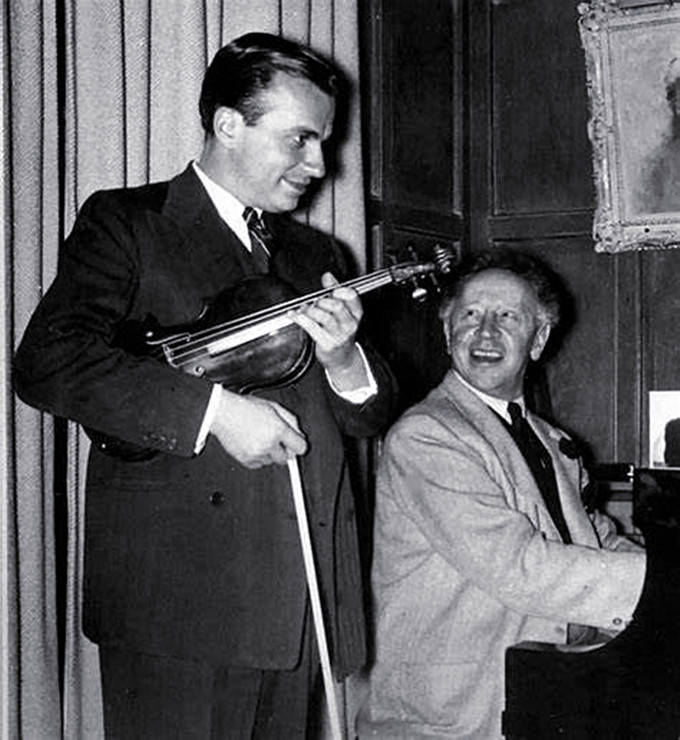 |
|
| |
谢霖与钢琴家阿图尔·鲁宾斯坦 |
|
|
|
| |
名师与名琴——谢霖邂逅并拥有的几把名琴 |
|
|
|
| |
1954 年,阿图尔·鲁宾斯坦建议他应该重新开始他的职业生涯。 谢霖已经做好了准备,并在二重奏音乐会和与他的波兰同胞录音的宣传帮助下,开始了辉煌的成名之路。
他与墨西哥保持着联系,拥护查韦斯和庞塞等作曲家——当我 50
多年前第一次听到他的声音时,他对中美洲和南美洲作品的渲染令人眼花缭乱——并于 1956 年被任命为墨西哥官方文化大使,持外交护照旅行。 1970 年,他成为墨西哥驻巴黎联合国教科文组织代表团的文化顾问。 在这段时间里,他一直在进行一流的音乐会和录音生涯。
他抽出时间成为一名优秀的钢琴家,这项技能让他对他的二重奏伙伴有了非凡的了解。
他会在下班后为朋友弹奏爵士钢琴,尽管他说:“我总是不愿用小提琴演奏那种音乐。” |
|
|
|
| |
In 1954
Artur Rubinstein suggested he should resume his career. Szeryng was
ready and, helped by publicity generated by duo concerts and recordings
with his fellow Pole, began a brilliant rise to fame. He retained his
links with Mexico, championing composers such as Chávez and Ponce – when
I first heard him more than 50 years ago, he dazzled with his renderings
of Central and South American pieces – and in 1956 was made an official
Mexican cultural ambassador, travelling on a diplomatic passport. In
1970 he became cultural adviser to Mexico’s UNESCO delegation in Paris.
All this time he carried on a front-rank concert and recording career.
And he found time to be a fair pianist, a skill that gave him an
exceptional understanding of his duo partners; he would play jazz piano
for friends after hours, although he said: ‘I was always reticent to use
the violin for that kind of music.’ |
|
|
|
| |
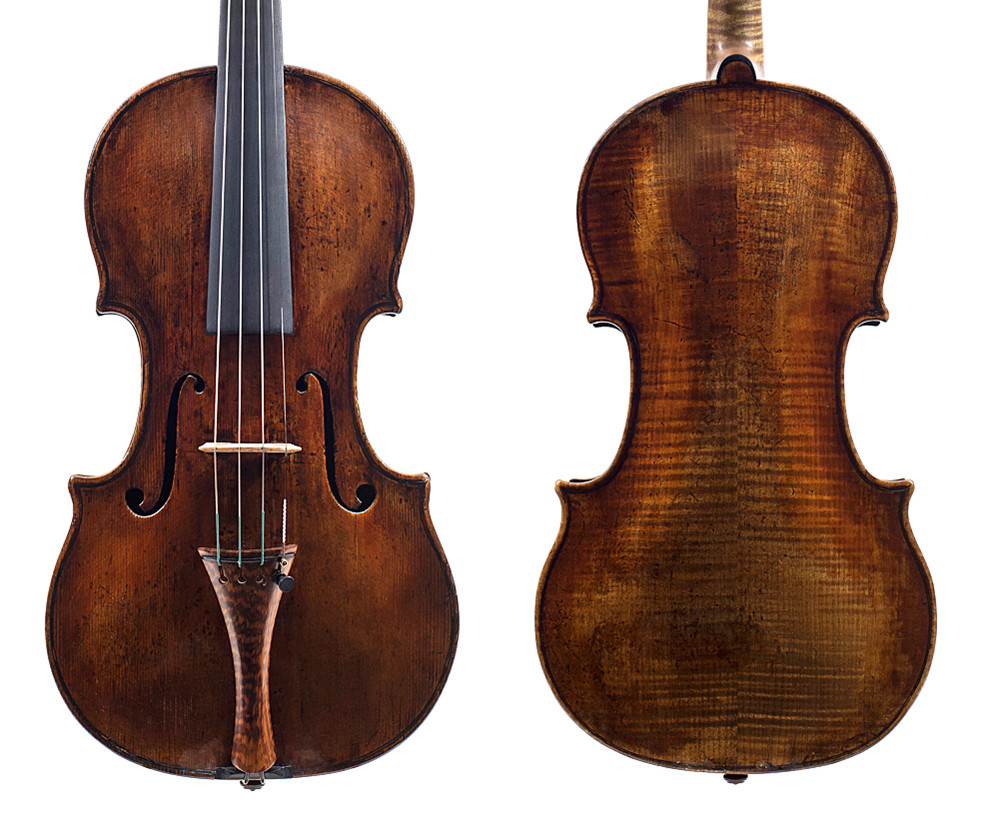 |
|
| |
第二次世界大战期间由谢霖演奏的托马索·埃伯勒小提琴 |
|
|
|
| |
我们可以确定,谢霖拥有的第一把小提琴是1760年的托马索·埃伯勒(Tomaso
Eberle),他从1938年到1946年拥有这把小提琴:在战争期间,它是为了一些艰苦的用途而来的。
1978年,他对西蒙·柯林斯说:“我对只做我的工作不太满意,幸运的是,我被允许随身携带我的小提琴——当时它不是斯特拉、瓜纳里、阿马蒂或鲁吉里,也不是塞鲁蒂、卡卡西或瓜达
尼尼,但它是一把很好的小提琴,我喜欢演奏它。
没有人真正知道它是什么——它应该是一个埃伯勒:具有威尼斯影响力的泰勒。
不管怎样,这对我来说听起来很好,我演奏了很多音乐会-我想说是300多场-为受伤的和生病的盟军的伤病员,为了他们的家人,甚至为了战俘。这把历史上重要的小提琴目前在阿根廷。 |
|
|
|
| |
The first violin
we can be sure Szeryng owned was the c. 1760 Tomaso Eberle he had from
1938 to 1946: it came in for some strenuous use during the war. ‘I was
not quite satisfied with only doing my duty,’ he told Simon Collins in
1978, ‘and fortunately I was permitted to carry my violin with me – at
that time it was not a Strad, a Guarnerius, Amati or a Ruggieri, nor was
it a Ceruti, Carcassi or a Guadagnini, but it was a nice violin and I
liked to play it. Nobody really knew what it was – it was supposed to be
an Eberle: Tyrolean with a Venetian influence. Anyway, it sounded fine
to me, and I played very many concerts – I would say over 300 – for
casualties, for the wounded and sick members of the Allied forces, for
their families and even for prisoners of war.’ This historically
important violin is now in Argentina. |
|
|
|
| |
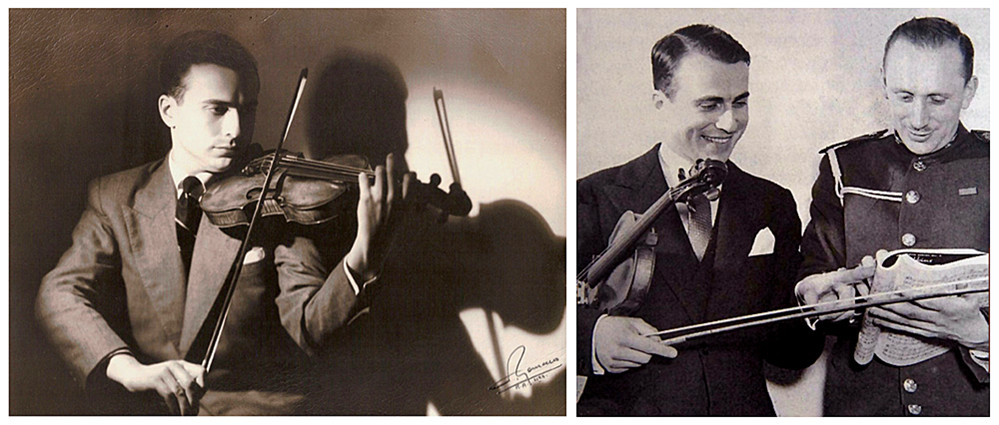 |
|
| |
左:亨利克·谢霖在1944年使用埃伯勒演奏;右:1943年少校柯克伍德在加拿大,1943年。 |
|
|
|
| |
在他的鼎盛时期,谢霖习惯性地有两把小提琴,一把是瓜奈里家族德尔吉苏和一把是斯特拉迪瓦里,并交替使用。
他说:“幸运的是,斯特拉迪瓦里的音调足够暗,瓜奈里的光线足够轻,这样的转变不会让人感到痛苦。
从1957年左右开始,他从菲普斯家庭基金会借了勒杜克“Leduc”Guarneri,并最终在1970年买下了它。
这把小提琴被认为是“德尔吉苏”制造的最后一把小提琴,有一个糟糕的文字标签,可以追溯到1745年,也就是卢蒂埃去世的那一年,所以人们多次尝试把日期读为1743年,或者把它伪装成“c。
1744’。 一些人推测,古纳里的妻子卡塔琳娜可能在他死后完成了这件乐器。
无论对其完成的困惑,‘Leduc’被雅克·弗兰西斯描述为世界上最好的音乐会小提琴之一。 |
|
|
|
| |
In his heyday,
Schelling habitually owned two violins, a Guarneri family 'del Gesu' and
a Stradivari, and used them alternately. He said: “Fortunately, the
Stradivari was dark enough in pitch and Guarani light enough that such a
transition wouldn’t be painful. Beginning around 1957, he grew up from
the Phipps family. The Foundation loaned Leduc "Leduc" Guarneri and
eventually bought it in 1970. The violin, believed to be the last violin
"Derguessue" made, has a poor text label that dates back to 1745, the
year Loutiere died, so there have been many attempts to read the date as
1743, or disguise it as "c. 1744’. Some speculate that Gunari's wife,
Katarina, may have completed the instrument after his death. Regardless
of the confusion over its completion, the 'Leduc' is described by
Jacques Francis as one of the best concert violins in the world. |
|
|
|
| |
|
|
|
|
| |
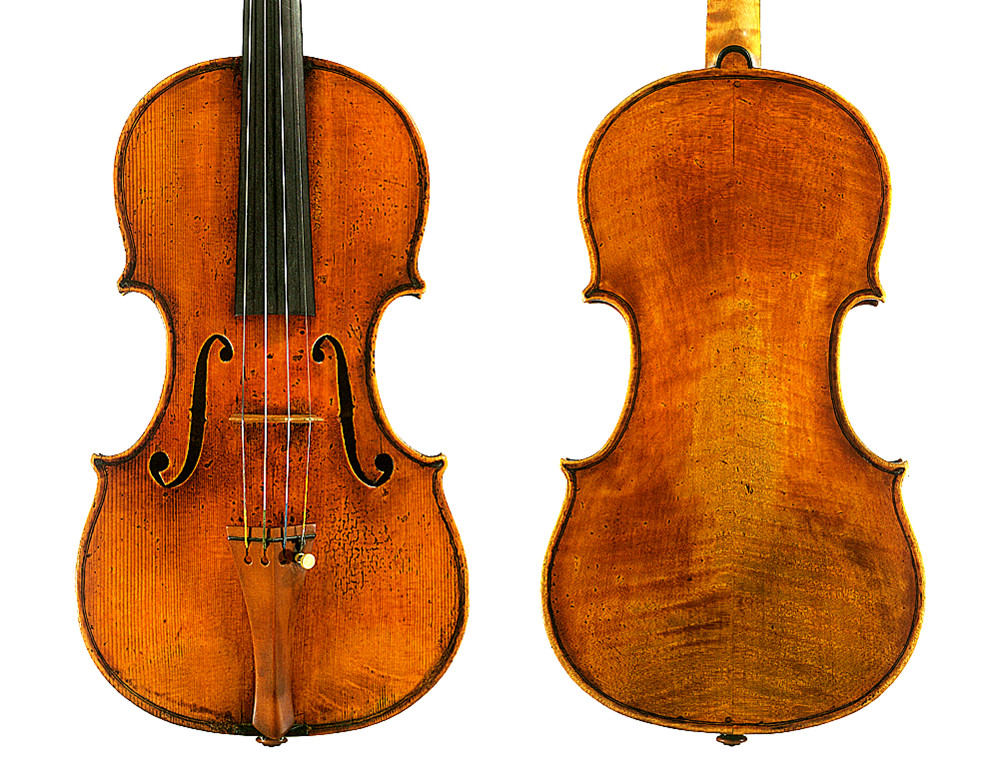 |
|
| |
Leduc”Guarneri。 照片:彼得·比道夫 |
|
|
|
| |
谢霖的斯特拉迪瓦里是1734年的“大力神”,曾经是尤金·耶萨伊拥有的,但1908年从圣彼得堡帝国剧院的绿色房间被偷,而伊萨伊则在舞台上演奏他的瓜拉尼。
1925年,在巴黎一家经销商的商店里,斯特拉德被收购,当时是阿尔萨斯小提琴家卡尔·蒙奇,当时是莱比锡·格万德豪斯的音乐会主唱,后来被他的妻子以指挥查尔斯·蒙奇而闻名。
谢霖最初从蒙奇那里借了“大力神”来表演舒曼协奏曲,并于1962年1月以4万$的价格从他那里买下了它。
加里·格拉夫曼和谢霖在华盛顿的国会图书馆出现过几次,他回忆道:“他带着两把小提琴,一把斯的拉底和一把德尔吉苏“del
Gesu”,我的妻子不得不坐在后台,不管他用的是什么。”谢霖显然不会犯与Ysaye相同的错误!
然而,他并不反对让一位有价值的同事演奏他的乐器,正如他的同窗弗莱斯奇的学生彼得·里巴(Peter
Rybar)在温特图尔的长期音乐会大师)所断言的那样:“当亨利克·谢霖来参加他在温特图尔的第一次排练时,他期待着演奏勃拉姆斯,并被告知管弦乐队期待演奏柴可夫斯基!
其中一位董事会成员,他有一位很好的斯坦威,总是邀请独奏者共进晚餐,通常也和我一起。 谢霖告诉我他知道我的舒曼记录。
“我喜欢那首协奏曲,”他说。为了喝咖啡,我们不得不走进沙龙,但在那一刻,亨利克牵着我的胳膊走向斯坦威,说:“这是我的箱子,打开它,拿出我的一把小提琴”,然后坐下来,我们
合作了整个舒曼协奏曲,谢霖用心演奏。”(与Rybar的友谊是不朽的,更好的是谢霖的两张巴赫双协奏曲的录音。)
1972年,亨利克·谢霖向耶路撒冷的Teddy Kollek市长捐赠了斯特拉迪瓦里,以纪念即将到来的以色列国的银禧。 现在被称为“Kinor
David”(大卫的抒情诗),它被以色列爱乐音乐会主持人使用。 |
|
|
|
| |
Schelling's
Stradivari is 1734's "Hercules", once owned by Eugene Yesay, but stolen
from the green room of the Imperial Theater in St. Petersburg in 1908,
while Isaiah was on stage Play his guarani. In 1925, in the shop of a
Parisian dealer, Strader was acquired by the Alsatian violinist Karl
Monchi, then the concert lead singer of the Leipzig Gewandhaus, who was
later taken over by his wife. Known for conducting Charles Munch.
Schellinger initially borrowed "Hercules" from Munch to perform the
Schumann Concerto, and bought it from him in January 1962 for $40,000.
Gary Graffman and Schelling, who made several appearances at the Library
of Congress in Washington, recalled: "He carried two violins, a stiletto
and a del Gesu, my The wife had to sit backstage, no matter what he was
using." Sheerin obviously wouldn't make the same mistake as Ysaye!
However, he was not averse to having a worthy colleague play his
instrument, as asserted by his classmate Flesch's student Peter Rybar
(longtime concert master in Winterthur) That way: "When Henrik Schelling
came to his first rehearsal in Winterthur, he was expecting to play
Brahms and was told that the orchestra was expecting to play
Tchaikovsky! One of the board members, He had a good Steinway and always
invited the soloists to dinner, usually with me too. Schellinger told me
he knew my Schumann record. "I liked that concerto," he said. For a
drink Coffee, we had to walk into the salon, but at that moment Henrik
took me by the arm and walked up to Steinway and said, "Here's my
suitcase, open it up and get out one of my violins" and sat down, We
went through the entire Schumann concerto, and Schellinger played it
with heart." (The friendship with Rybar is immortal, and even better is
the recording of Schellinger's two Bach double concertos.) In 1972,
Szeryng to Teddy in Jerusalem Mayor Kollek donated the Strad in honor of
the upcoming Jubilee of the State of Israel. Now known as "Kinor David"
(Lyric of David), it was used by the Israel Philharmonic concert
presente |
|
|
|
| |
|
|
|
|
| |
Today in the
history of music
Mexican Polish violinist Xie Lin was born in Warsaw, Poland, on
September 22, 1918.
Henryk Szeryng (1918-1988) was a Mexican violinist born in Warsaw,
Poland.At the age of seven, his talent was recognized by the Polish
violin master Hubermann, who recommended him to Berlin as a disciple of
Fleisch, thus laying a solid foundation.In 1930 he transferred to the
Paris Conservatory, where he studied under French masters Tibbo and
Blanger. He graduated six years later.
In 1944, Xie Lin was inspired by Pence, the father of Mexican music, and
moved to the country. Two years later, he acquired citizenship and
became a Mexican citizen.He is regarded as one of the most outstanding
interpreters of Bach's works.During World War II, he served as a
translator for the Polish government-in-exile and withdrew to Mexico.
Later, he became a Naturalized Mexican citizen and served as a cultural
ambassador on a diplomatic passport.
In 1954, encouraged by his friend Rubenstein to return to acting, he was
gradually recognized as one of the greatest violinists of the 20th
century.
Sherin took lessons at Hays, Fleish and Tibbo.His first recital was held
in 1933.He moved to Mexico in 1946 and taught in the music department of
the University of Mexico.He gained Mexican citizenship two years later.
Xie Lin's performance is compact and active, emphasizing the deep
expression of his works.He has long studied the music of the Baroque
period. His performance reflects the pure Baroque style, elegance and
preciseness, and he is regarded as a model in this respect. He is also
one of the most outstanding interpreters of Bach's works.
Henrik Schelling playing Beethoven's Violin
Concerto;Henrich Schelling, Paganini Violin Concerto No.
3 in E Major (World Premiere). |
|
|
|
| |
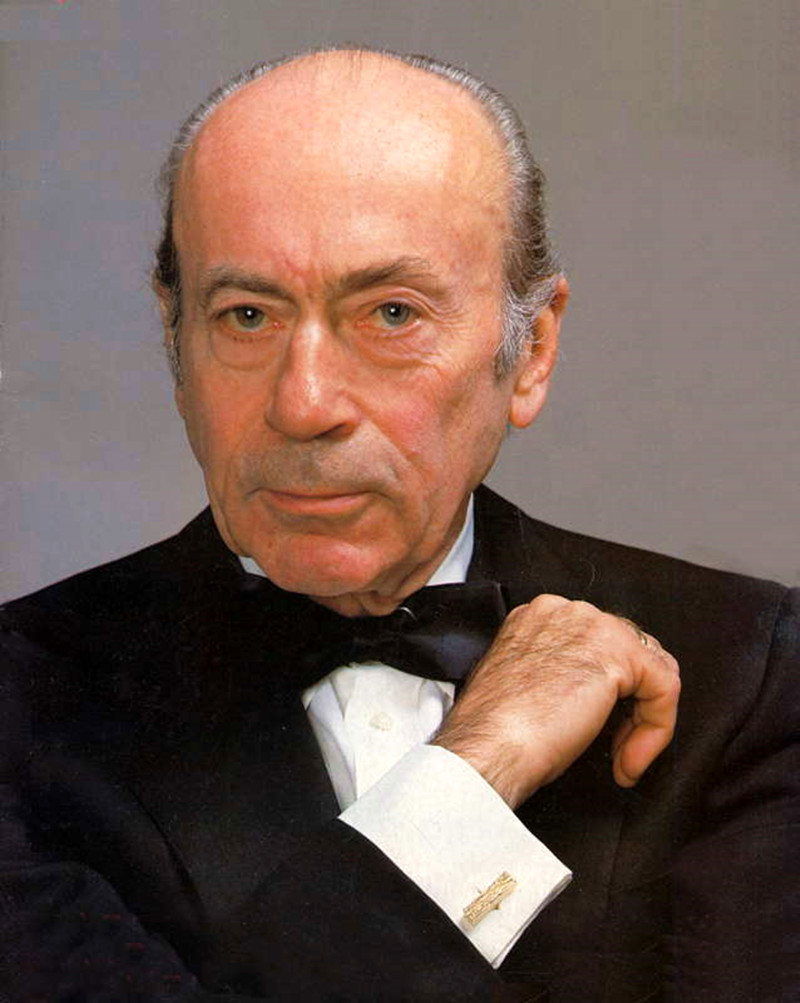 |
|
|
|
| |
扬·克伦茨(1926 - 2020)。照片
© 1993 安德烈亚·斯维特利克 |
|
|
|
| |
Jan Krenz
(1926-2020). Photo © 1993 Andrzej Świetlik |
|
|
|
| |
杨·克伦茨先生曾担任波兰国家广播交响乐团、华沙大剧院、丹麦广播乐团和克拉科夫爱乐乐团的首席指挥
他曾担任柏林爱乐乐团、德累斯顿国家交响乐团、音乐厅乐团、圣彼得堡爱乐乐团、底特律交响乐团等乐团的客座指挥。
在他的职业生涯中,他获得了许多荣誉,包括波兰“金十字勋章”、“指挥官十字勋章”和一级国家奖。 |
|
|
|
| |
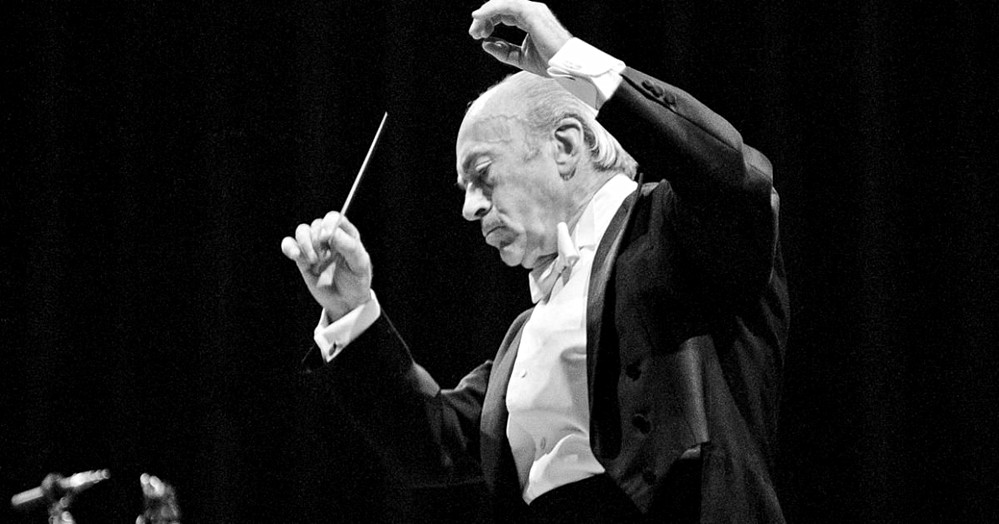 |
|
| |
扬·克伦茨(Jan Krenz)在指挥中 |
|
|
|
| |
Jan Krenz (Jan Krenz)
in conducting |
|
|
|
| |
Mr Krenz
served principal conducting positions with the Polish National
Radio Symphony, Warsaw's Grand Theatre, Danish Radio Orchestra,
and Krakow Philharmonic Orchestra
He guest conducted ensembles including the Berliner
Philharmoniker, Staatskapelle Dresden, Concertgebouw Orchestra,
Saint Petersburg Philharmonic Orchestra, and the Detroit
Symphony.
Throughout his career he was presented a number of accolades,
including a Polish "Golden Cross of Merit," "Commander's Cross
of the Order," and first degree State Award. |
|
|
|
| |
|
|
|
|
| |
|
|
| |
亨利克·谢林-帕格尼尼E大调第3小提琴协奏曲
1973年,布拉格之春
指挥:简•克兰兹
捷克交响乐团
|
|
|
|
| |
Henryk
Szeryng - Paganini Violin Concerto No 3 E Major
1973@Prague Spring Fes
Conductor: Jan Krenz
Czech Philarmonic Orchestra |
|
|
|
| |
|
|
|
|
| |
未得原作者编者授权严禁转载www.mt77.com任何内容 |
|
|
|
|
|
|
|
|
|
|
|
|
|
|


